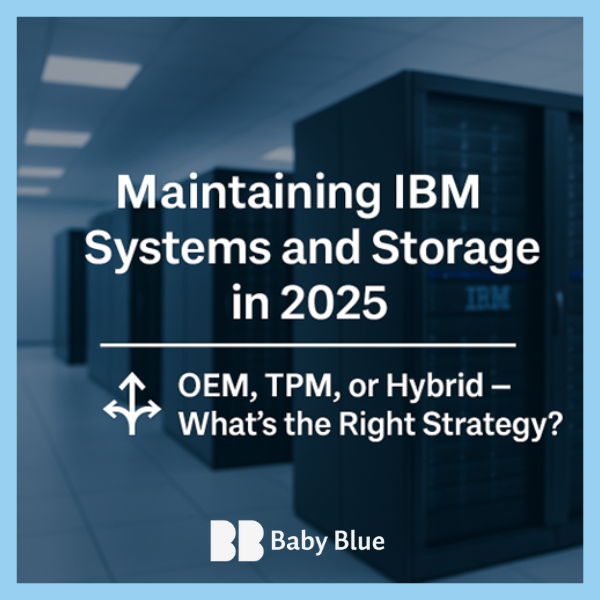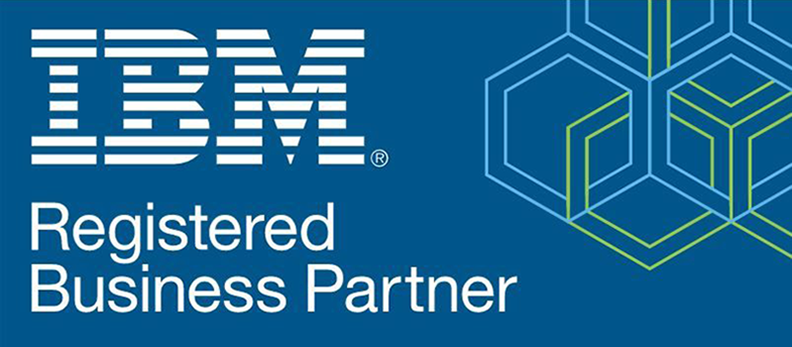Maintaining IBM Systems and Storage in 2025: OEM, TPM, or Hybrid?
30 April 2025 - 5 Minute Read
Introduction: The Support Dilemma in 2025
In 2025, enterprises running mission-critical IBM systems and storage face a pivotal decision regarding hardware maintenance. Should you stay with IBM, the Original Equipment Manufacturer (OEM), or move to a Third-Party Maintenance (TPM) provider?
The answer is no longer straightforward. While traditional perceptions of IBM and TPM services persist, the landscape has shifted significantly. Budget pressures, sustainability goals, ageing infrastructure, and changing service delivery models mean that businesses must now re-evaluate their support strategies carefully.
This article offers a clear, extended examination of the choices available today, what they used to be, what they have become, and how you can make the right decision for your estate.
The Traditional View
Historically, IBM maintenance was seen as the safe, in expensive, option.
Known for technical authority, but also for being:
- Expensive, with premium pricing that was rarely matched by premium service.
- Aloof, often more focused on ticketing systems and internal processes than proactive customer partnership.
- Slow, due to parts being stored centrally in Europe, causing delays in critical repairs.
- Demanding, sometimes placing the burden of hardware replacement directly onto customers.
Meanwhile, TPMs emerged to fill these gaps, offering:
- Specialist expertise, often provided by engineers with platform-specific skills and prior OEM experience, enabling faster and more personalised responses.
- UK-based parts stock and account-aligned engineers, supporting quicker fixes and bespoke service levels.
- End-to-end ownership and crucially, if a TPM could not resolve an issue, they could historically escalate the case to IBM on a Time and Materials (T&M) basis and absorb the cost themselves.
What’s Changed in 2025
The old assumptions no longer hold. Both IBM and TPMs have evolved but in very different ways.
IBM Has Stepped Up:
- UK parts holding now supports faster on-site repairs.
- Experienced engineers with regular training refreshes across IBM systems and storage.
- Firmware and microcode access for supported customers.
- Extended support beyond EOSL, often up to six years.
- Better value through consolidated hardware and software support.
TPMs Are Changing Too:
- Private equity ownership is reshaping the TPM space and in some cases, service levels have suffered.
- Some TPMs have replaced highly experienced IBM-trained engineers with lower-cost, less skilled resources, reducing the depth of technical expertise available for complex system support.
- Although experienced internal technical staff often deliver training within TPMs, they themselves have not received formal manufacturer-led education on the latest IBM technologies. Combined with a less experienced workforce, this results in a growing gap in technical quality compared to IBM’s engineering standards.
- Customer interactions increasingly via portals, reducing human touch.
- Reduced parts holdings, with reliance on just-in-time brokerage.
- Loss of IBM escalation on a T&M basis.
- EOSL used aggressively to drive customer decisions prematurely.
- Split support often costing more than direct OEM support.

Key Factors to Consider: OEM vs TPM
Expertise and Training: IBM’s direct manufacturer-led training ensures engineers remain current on both legacy and latest-generation systems. TPMs provide broad multi-vendor experience, but often lack access to official IBM technical updates and newer technology certifications.
Access to Firmware and Updates: Only IBM contract customers retain entitlement to ongoing firmware, microcode, and critical patch updates. This is essential for security, stability, and regulatory compliance.
Cost and Budget Pressures: TPM contracts often offer upfront savings, but when considering long-term risk, update access, and hidden costs, consolidated IBM support can prove better value.
Service Level Flexibility: TPMs are often able to offer highly tailored SLAs. IBM provides standardised but globally proven SLAs.
Parts Quality and Availability: IBM guarantees genuine, certified parts availability. TPMs, depending on their logistics and broker relationships, may experience variability in delivery times and part quality.
Support for End-of-Life Systems: TPMs remain strong for prolonging legacy system life. However, IBM’s extended EOSL support now provides another option for businesses prioritising continuity and sustainability.
Vendor Bias versus Independent Advice: IBM naturally recommends roadmap-aligned upgrades. TPMs offer greater neutrality - though buyers must scrutinise EOSL-driven sales pressure carefully.
The Hybrid Approach: Getting the Best of Both Worlds
A growing number of organisations are adopting a hybrid model, combining OEM and TPM support strategically.
- OEM Support: For critical, evolving, or compliance-sensitive IBM systems where firmware access, escalation pathways, and security updates are essential.
- TPM Support: For stable, mature systems where risk is lower, workloads are predictable, and commercial flexibility is a priority.
This hybrid approach enables businesses to optimise budgets, align service models to business risk, and retain control over upgrade timing and lifecycle management.
Conclusion: Who Really Has Your Back?
In 2025, both IBM and TPM providers offer important strengths.
IBM offers deeper expertise, secure firmware updates, stronger logistics, and an extended commitment to sustainability.
TPMs continue to provide flexibility, cost control, and valuable lifecycle extension for older infrastructure.
The smartest approach often lies in combining these strengths through a hybrid model tailored to your environment.
Choosing the right support strategy today is about balancing risk, cost, compliance, and operational resilience.
With clear insight and the right hybrid partner businesses can build robust, cost-effective maintenance strategies that genuinely support long-term business goals.
How Baby Blue Can Help
Choosing the right maintenance strategy in 2025 is more complex than ever but you don’t have to navigate it alone.
Baby Blue’s True Blue Hybrid Maintenance service is designed specifically to help IBM hardware users make smarter, clearer decisions.
Whether you need help protecting critical infrastructure, extending the life of stable systems, or balancing risk against cost, our team offers impartial advice based on real-world experience — not vendor targets.
We build flexible, de-risked support models that align with your business needs — not just the needs of the OEM or the TPM.
Speak to Baby Blue today to find out how we can help deliver the right hybrid maintenance solution for your business.
About the Author

Chris Smith
Chris Smith is a sales leader and consultant with over 30 years of experience in IT managed services. With a background in IBM hardware maintenance, he transitioned from field engineer to sales and marketing director, creating the foundations for Blue Chip Cloud, which became the largest IBM Power Cloud globally at the time. Chris played a key role in the 2021 sale of Blue Chip and grew managed services revenue by 50%. He’s passionate about building customer relationships and has implemented Gap Selling by Keenan to drive sales performance. Now, Chris helps managed service providers and third-party maintenance businesses with growth planning and operational improvement.
LinkedIn





